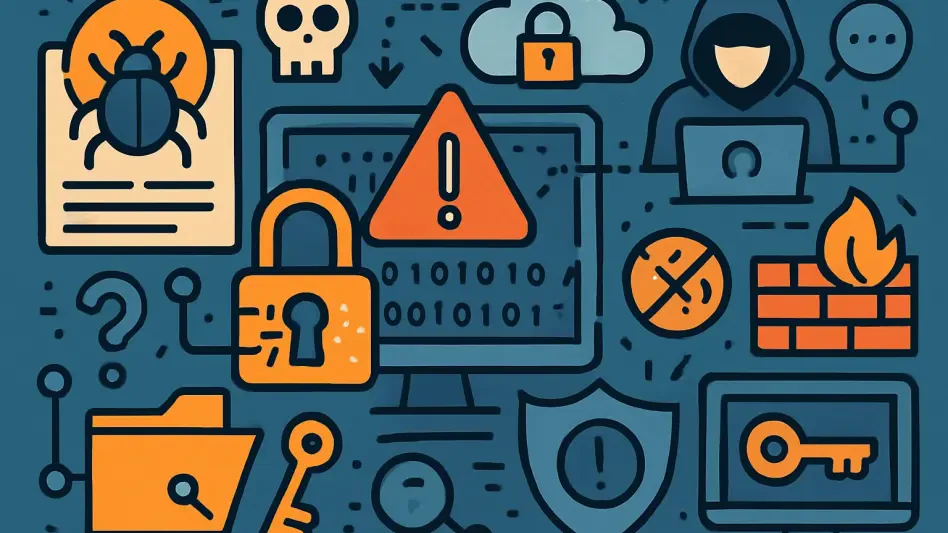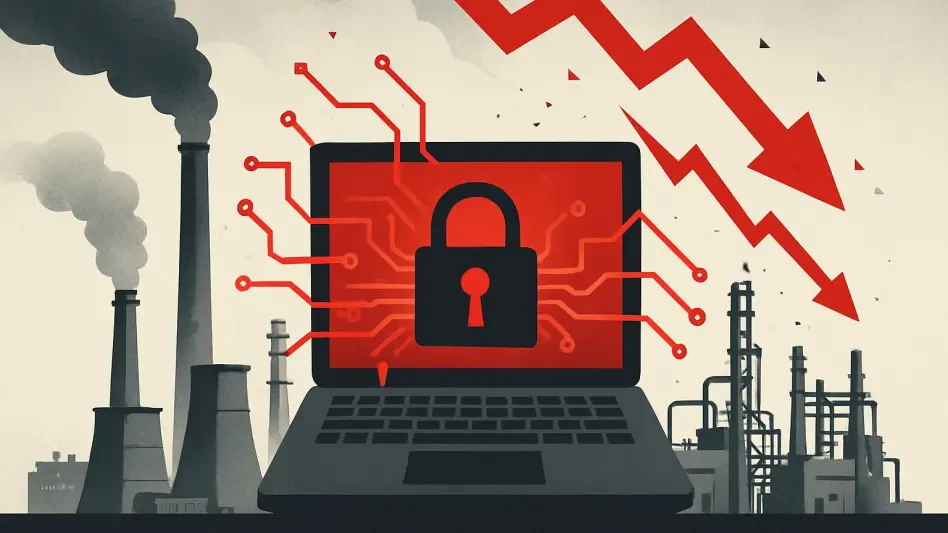In an era where digital infrastructure underpins nearly every aspect of society, the recent revelation of 908 new IT vulnerabilities in a single week, as detailed by Cyble Vulnerability Intelligence, sends a chilling message about the state of global cybersecurity. This staggering number of flaws, affecting everything from household-name software vendors to critical industrial systems, exposes a pervasive threat that transcends borders and industries. With 188 of these vulnerabilities accompanied by publicly available Proofs-of-Concept (PoCs), the door is wide open for malicious actors to exploit weaknesses with alarming ease. High-profile companies like Cisco, Apple, Microsoft, and Mozilla are among those impacted, alongside industrial control systems (ICS) integral to energy, transportation, and manufacturing sectors. The severity of the situation is underscored by the fact that 105 of these vulnerabilities are rated critical under the CVSS v3.1 scoring system, with an additional 25 under CVSS v4.0, pointing to potential catastrophic outcomes like remote code execution or system-wide compromise. This crisis demands immediate attention as the pace of exploitation accelerates, leaving organizations scrambling to defend against an ever-growing wave of cyber threats.
The Scale and Speed of Exploitation
Rapid Transition to Weaponization
The breakneck speed at which newly discovered vulnerabilities are turned into active threats is a defining challenge in today’s cybersecurity landscape. With over 20% of the 908 identified flaws having public PoCs readily available, attackers can exploit these weaknesses almost immediately after disclosure. This rapid weaponization often outstrips the ability of many organizations to implement patches or other defensive measures, leaving systems exposed during critical windows of vulnerability. The situation is exacerbated by the accessibility of exploitation tools, which lowers the technical barrier for malicious actors, enabling even those with limited expertise to launch devastating attacks. As a result, the traditional timeline for remediation—once measured in weeks or months—has now collapsed into mere days or hours, placing unprecedented pressure on IT teams to act swiftly and decisively to protect their digital assets from compromise.
Need for Proactive Defenses
Addressing this accelerated threat landscape requires a fundamental shift toward proactive vulnerability management rather than reactive responses. Organizations must adopt strategies that prioritize early detection and rapid response, leveraging threat intelligence to anticipate potential exploits before they occur. The sheer volume of vulnerabilities, combined with the speed of exploitation, means that waiting for patches to be released and applied is no longer a viable option in many cases. Instead, implementing robust monitoring systems to identify unusual activity and deploying interim mitigations can buy valuable time. Additionally, fostering a culture of cybersecurity awareness across all levels of an organization ensures that potential risks are flagged early. The reality is clear: as attackers continue to capitalize on shrinking remediation windows, only those entities that embrace a forward-thinking approach will stand a chance against the relentless pace of modern cyber threats.
Targeting Critical Systems and Infrastructure
Widespread Impact on Software and Services
The breadth of systems affected by these 908 vulnerabilities is nothing short of staggering, cutting across both enterprise and consumer technologies with equal ferocity. Enterprise software, such as Microsoft SharePoint and Fortinet FortiSIEM, which are cornerstones of business operations, have been found to harbor critical flaws that could lead to data breaches or system takeovers. Similarly, consumer-facing products like Apple’s operating systems and Mozilla Firefox are not spared, exposing millions of users to potential risks of personal data theft or device compromise. The implications of these vulnerabilities ripple outward, affecting not just individual users but also the organizations that rely on these tools for daily operations. This widespread impact emphasizes that no digital environment is immune, and the consequences of failing to address these flaws can range from financial loss to reputational damage, underscoring the urgent need for comprehensive security measures across all platforms.
Risks to Critical Infrastructure
Even more concerning is the targeting of industrial control systems (ICS) that form the backbone of critical infrastructure, with vulnerabilities identified in products from Siemens and Rockwell Automation. These systems, essential to sectors like energy, transportation, and manufacturing, are often interconnected with physical processes, meaning that a cyber breach could have real-world consequences far beyond data loss. Disruptions to power grids, water supplies, or transit networks could endanger public safety and destabilize economies on a massive scale. The high severity of many ICS flaws, often allowing for remote access or control, amplifies the risk, as attackers could exploit these vulnerabilities to cause physical harm or widespread chaos. Protecting operational technology environments has thus become as vital as securing traditional IT systems, demanding specialized strategies that account for the unique challenges of safeguarding infrastructure against digital threats.
Evolving Threats and Cybercrime Activity
Dark Web as a Catalyst for Attacks
A particularly insidious aspect of the current cybersecurity crisis is the thriving underground economy on dark web forums, where threat actors actively trade zero-day exploits and other malicious tools. High-value targets such as Safari Browser and Windows systems are among those for which exploits are reportedly being sold, often before vendors can even develop patches. This underground activity significantly heightens the risk, as it equips attackers with the means to strike undetected, exploiting vulnerabilities that are unknown to defenders. Moreover, new attack campaigns, such as those targeting Citrix NetScaler as detected by Cyble’s honeypot sensors, illustrate the tangible impact of these transactions, with real-world breaches occurring at an alarming rate. The sophistication of this cybercrime ecosystem reveals a stark reality: attackers are not only keeping pace with security advancements but are often a step ahead, necessitating constant vigilance and innovative countermeasures.
Adapting to Sophisticated Threat Actors
The evolving tactics of threat actors demand that cybersecurity strategies evolve in tandem to address increasingly sophisticated attacks. Beyond merely exploiting known vulnerabilities, malicious entities are now orchestrating coordinated campaigns that combine multiple exploits for maximum impact, often targeting specific industries or regions. The sale of zero-day exploits on dark web platforms indicates a level of organization and resourcefulness that challenges traditional defense mechanisms. Organizations must therefore invest in advanced threat intelligence capabilities to monitor underground activities and predict potential attack vectors. Additionally, adopting a Zero Trust security model, which assumes no entity is inherently trustworthy, can help mitigate risks by enforcing strict access controls. As cybercrime continues to professionalize, staying ahead requires not just technical solutions but a holistic approach that anticipates the next moves of an ever-adapting adversary.
Strategies for a Safer Digital Future
Prioritizing Risk-Based Mitigation
Looking ahead, the path to mitigating the impact of these 908 vulnerabilities lies in adopting a risk-based approach to cybersecurity that focuses on the most pressing threats. Organizations must prioritize vulnerabilities based on their severity, exploitability, and potential impact, rather than attempting to address every flaw simultaneously. This means allocating resources to critical systems first, ensuring that patches or workarounds are applied where the risk of compromise is highest. Tools like attack surface management can provide visibility into exposed assets, helping to identify and secure weak points before they are exploited. Furthermore, integrating best practices such as network segmentation and continuous monitoring can limit the spread of an attack if a breach occurs. By focusing on calculated, strategic responses, entities can build resilience against the overwhelming tide of vulnerabilities that threaten global security.
Leveraging Threat Intelligence for Defense
Reflecting on the challenges posed by these vulnerabilities, it’s evident that leveraging threat intelligence has been a crucial step taken by many organizations in their efforts to stay ahead of attackers. In the past, insights into dark web activities and emerging attack campaigns, as provided by reports like Cyble’s, proved invaluable for anticipating threats and fortifying defenses. Solutions such as credential monitoring and external threat profiling helped identify risks before they materialized into full-scale attacks. The emphasis on ransomware-resistant backups and Zero Trust access models also played a significant role in minimizing damage from successful exploits. Moving forward, the continued use of such intelligence-driven approaches, combined with collaboration across industries to share knowledge and resources, offers a promising avenue for reducing the global impact of cyber threats and securing digital environments for the long term.








